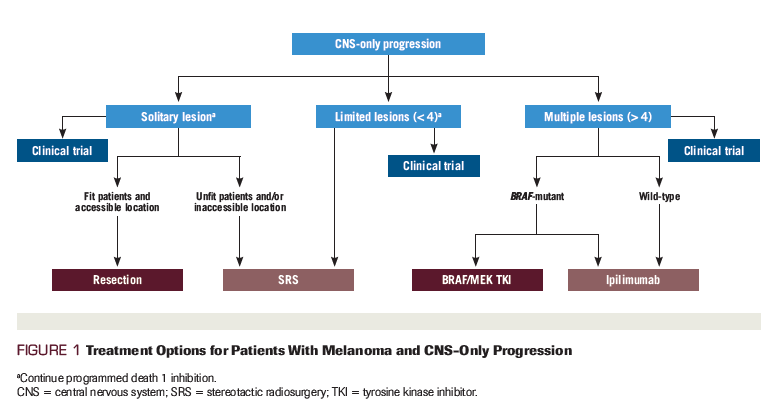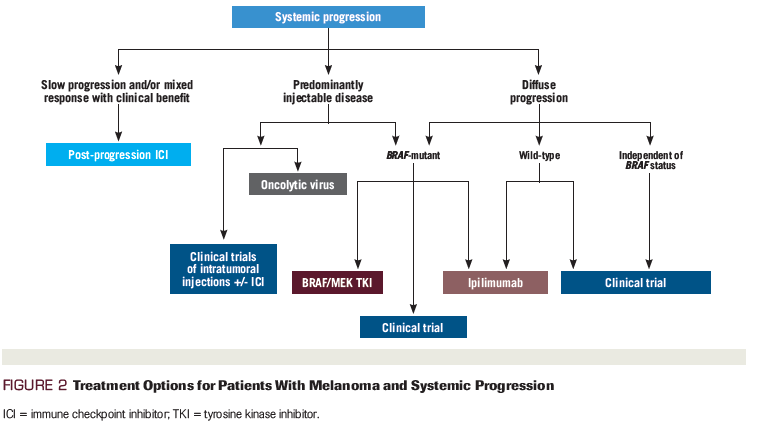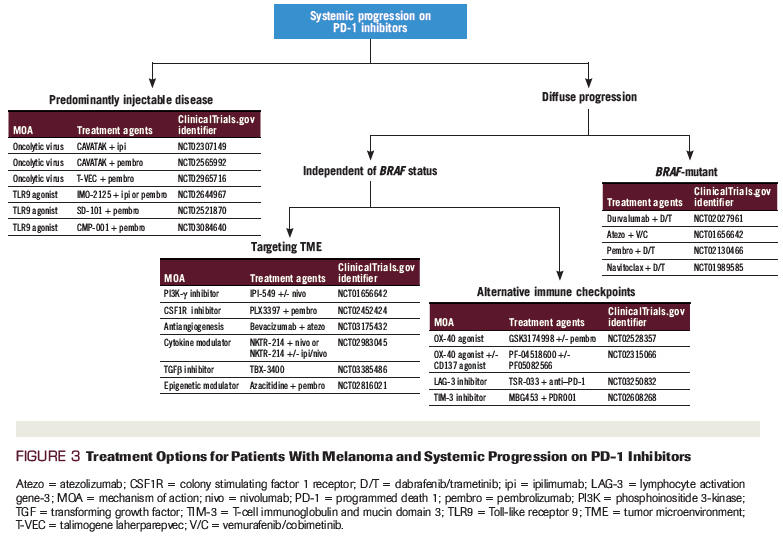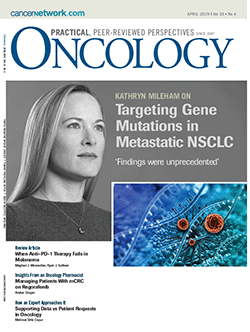What to Do When Anti–PD-1 Therapy Fails in Patients With Melanoma
This review summarizes the current available treatment strategies for patients with advanced melanoma when PD-1–directed therapy is not enough.
Oncology (Williston Park). 33(4):141-8.

Meghan J. Mooradian, MD

Ryan J. Sullivan, MD

Figure 1. Treatment Options for Patients With Melanoma and CNS-Only Progression

Figure 2. Treatment Options for Patients With Melanoma and Systemic Progression

Figure 3. Treatment Options for Patients With Melanoma and Systemic Progression on PD-1 Inhibitors

Monotherapy with immune checkpoint inhibitors, specifically those targeting programmed death 1 (PD-1), has revolutionized the treatment of metastatic melanoma: approximately 40% of patients achieve a partial or complete response, many of which are durable. However, a subset of patients who initially respond to therapy will progress, leaving the majority of patients in need of an effective second-line approach. While some standard therapies exist, there has been robust interest in utilizing targeted immunotherapy combinations in this population to overcome primary or acquired resistance. Other approaches include treatment with anti–PD-1 agents beyond progression; targeting oligometastatic disease with surgery, radiation, and/or intratumor injections; and the use of other approved systemic therapies. This review summarizes the current available treatment strategies for patients with advanced melanoma when PD-1–directed therapy is not enough.
Introduction
The use of immune checkpoint blockade has revolutionized the treatment of metastatic melanoma, with dramatic improvements in cancer-related outcomes since the advent of these agents. Long-term survival data demonstrate durable disease control in 20% and 30% of patients receiving the cytotoxic T-lymphocyte–associated antigen 4 (CTLA-4) antagonist ipilimumab and the programmed death 1 (PD-1) inhibitor pembrolizumab, respectively.[1,2] However, a subset of patients-approximately 40% to 45%-experience no response to therapy, with clear de novo resistance (primary resistance). The reasons for primary resistance include inadequate T-cell infiltration into the tumor, as well as immunosuppressive factors within the tumor microenvironment.[3,4] Treatment strategies to overcome these obstacles range from adoptive T-cell therapy to stimulate tumor antigen–specific T cells, to mitogen-activated protein kinase (MAPK) inhibition to improve T-cell trafficking into the tumor.[5]
In contrast to primary resistance, approximately 30% to 40% of patients experience an initial response but ultimately progress months or even years later (acquired resistance). The mechanisms of acquired resistance, like primary resistance, are incompletely understood; however, they include loss of T-cell function through expression of alternative immune checkpoints (such as T-cell immunoglobulin and mucin domain 3 [TIM-3]),[6] disruption of interferon (IFN) gamma signaling via JAK2 mutations,[7,8] and impaired antigen presentation via altered expression of beta-2 microglobulin or major histocompatibility complex molecules.[8-10] Efforts to surmount acquired resistance include PD-1 inhibition coupled with agents targeting additional complementary immune checkpoints, such as TIM-3, CD137, and colony-stimulating factor 1 receptor (CSFR1). Advancements in deconstructing these resistance mechanisms have spurred the development of rational strategies to treat patients who have progressed on anti–PD-1 monotherapy, which will be highlighted in this review.
Post-Progression Continuation of PD-1 Inhibitors
Prior to transitioning to an alternative treatment approach, clinicians can consider continuing the use of PD-1 inhibitors after progression occurs. Whereas disease progression on chemotherapies and tyrosine kinase inhibitors (TKIs) almost uniformly results in treatment discontinuation due to futility of continued therapy, studies demonstrate the possibility of atypical and delayed response with immune checkpoint inhibitor therapy beyond Response Evaluation Criteria in Solid Tumors (RECIST)-defined progression in melanoma.[11,12] Mechanisms to account for these atypical presentations include delayed antitumor response, as well as “pseudoprogression,” in which a transient immune infiltration causes a paradoxical enlargement of the tumor with subsequent shrinkage and clinical benefit that transcends response rate (eg, overall survival (OS) benefit independent of response rate). Two retrospective studies evaluated the benefit of anti–PD-1 antibody therapy past progression in patients with metastatic melanoma.[11,12] Impressive response rates of 19% and 28% were seen in evaluable patients treated beyond progression, with these cases representing 4% and 5% of all patients who had received PD-1 inhibition in these studies, respectively. Notably, delayed responses were rare after 6 months, with these events likely indicative of true progressive disease.
In both studies, there was no increased safety signal for those treated beyond progression. Patients who derived the most benefit from continuation of immune checkpoint inhibitor therapy were more likely to be fit (Eastern Cooperative Oncology Group performance status of 0), with lower levels of lactate dehydrogenase. Though it remains difficult to identify patients who will derive benefit post-progression, in general, clinicians can consider PD-1 continuation with short-term follow-up in certain cases. Ideal candidates include those who appear to be deriving clinical benefit (eg, mixed response, slowed rate of progression, regression in critical areas with growth in non-critical areas), provided that they did not experience rapid progression, tolerated therapy well, are maintaining a good performance status, and would not experience an immediately life-threatening issue due to predicted further progression.
Oligoprogression
Patients who progress in a limited number of sites (four or fewer) while on immune checkpoint inhibitor therapy often benefit from a comprehensive, multidisciplinary approach-including incorporation of local therapy, such as surgical resection or ablative radiotherapy-to eradicate isolated site(s) of progressive disease and thereby render a more durable response.
Extracranial oligoprogression
Prior to the advent of effective immune checkpoint and targeted therapies, metastasectomy was often the only means of managing progressive disease.[13,14] Studies in the current era of immunotherapy continue to demonstrate improved outcomes of surgical resection in select cases, including in gastrointestinal (GI) tract–only disease,[15] large single brain metastasis,[16] and adrenal metastasis.[17] However, surgery is not feasible in all scenarios, and definitive radiation should be considered in such cases. Radiation therapy provides not only the ability to palliate symptoms, but also to eradicate a resistant subclone when used at definitive doses. One appealing benefit of radiation therapy is its theoretical ability to modulate an immune response and thereby synergize an anticancer effect when used concurrently with immune checkpoint inhibitor therapy. The abscopal effect-a phenomenon in which local radiation therapy is associated with regression of metastatic sites distant from the radiated site-has been reported in patients treated with both radiation therapy and immune checkpoint inhibitor therapy.[18,19] However, it has yet to be prospectively validated.
The safety of radiation therapy in patients receiving immune checkpoint inhibitor therapy has been explored in various studies, with data demonstrating an acceptable safety signal with treatment of various extracranial sites of disease.[20-23] However, when considering the ideal combination of radiation therapy and immune checkpoint inhibitor therapy, there are several variables that require further investigation, including, but not limited to: the ideal dose, optimal timing of radiation therapy, and how much to fractionate. While certain preclinical studies highlight the immunogenic properties of an ablative radiotherapy dose of 15 to 25 Gy in a single fraction,[24] other studies showcase the potential immunosuppressive effects of radiation, particularly of prolonged fractionated radiation therapy, which depletes circulating lymphocytes.[25] Several prospective studies across tumor types have demonstrated that stereotactic body radiation therapy (SBRT), or a hypofractionated method of delivery, may reduce this iatrogenic effect and lead to a more effective antitumor response.[26-28] While the optimal combination regimen is unknown, the available data do demonstrate that immune checkpoint inhibitor therapy with radiation, particularly short-course SBRT, appears to be a safe and potentially synergistic treatment option for the management of melanoma.
Central Nervous System–only progression
Development of intracranial disease is a common cause of morbidity and mortality. Management entails a multidisciplinary discussion, since treatment options vary based on patient- and tumor-specific factors (Figure 1). Surgical resection is often beneficial in cases of a single surgically-accessible metastasis.[16] In cases where surgery is not permissible (eg, poor performance status, medical comorbidities, or metastases in critical locales such as the brain stem), stereotactic radiosurgery has been proven to be a highly effective local therapy.[29] Radiosurgery enables treatment of individual brain metastases using high-dose single-fraction radiation, while sparing the surrounding normal brain and thereby mitigating side effects. Based on the efficacy and acceptable side effect profile of stereotactic radiosurgery, this treatment modality is often pursued in cases of ≤ 4 brain metastases that are ≤ 3 cm in diameter.[30]
The safety and efficacy of cranial radiation therapy with concurrent administration of immune checkpoint inhibitor therapy has become an area of interest. Recent retrospective studies demonstrate an acceptable safety signal,[31,32] with favorable cancer-related outcomes (eg, reduced size of brain metastases and decreased number of new lesions) in patients who received radiation in combination with immune checkpoint inhibitor therapy compared with patients who received radiation alone.[33] A recently published meta-analysis examined a total of 534 patients with a collective 1,570 brain metastases who were treated with immune checkpoint inhibitor therapy and stereotactic radiosurgery; researchers examined the safety and efficacy of a concurrent vs sequential approach, with sequential defined as administration of stereotactic radiosurgery and immune checkpoint inhibitor therapy within 4 weeks of each other.[34] The primary endpoint was the 1-year overall survival rate with a secondary endpoint of radionecrosis incidence. The 1-year OS rate was 64.6% vs 51.6% for concurrent and non-concurrent therapy, respectively. Overall, the incidence of radionecrosis was 5.3%, with rates higher in patients receiving concurrent CTLA-4 antagonists vs PD-1 inhibitors.
In patients with multiple CNS lesions, local therapy options are limited. Strategies for these individuals include alternative systemic agents that penetrate the blood-brain barrier, such as ipilimumab,[35] and combination BRAF/MEK inhibitors in patients harboring an activating BRAF mutation. However, despite achieving high rates of intracranial disease control, the majority of patients have abbreviated progression-free survival (PFS) on targeted agents.[36,37] Notably, although research has been conducted on the efficacy of combination nivolumab and ipilimumab in treatment-naive brain metastases,[38] there are little data on the efficacy of salvage combination therapy in patients who develop CNS disease while on PD-1 inhibitors.
Systemic Progression
In cases of systemic progression, subsequent treatment selection depends on several factors, such as the molecular features of the tumor, site of progression, and clinical trial availability (Figure 2). The treatments mentioned here-which include standard therapies as well as investigational strategies-are categorized by the presence of injectable disease and BRAF status; the final subgroup highlights additional novel combination regimens under development.
Progression in predominantly injectable disease
Oncolytic viruses. The presence of accessible soft tissue lesions enables the use of injectable agents, such as oncolytic viruses. These innovative treatments, often compromised of wild-type and modified live viruses, favorably modulate the tumor microenvironment by increasing CD8+ T-cell infiltration and upregulating the IFN gamma gene signature.[39,40] Though research on the efficacy of oncolytic virus administration post–PD-1 progression is limited, some data have demonstrated the efficacy of these agents with and without immune checkpoint inhibitors in treatment-naive patients.[39,41,42] Talimogene laherparepvec was the first oncolytic virus to demonstrate efficacy in a phase III clinical trial.[41] It has since been studied in combination with pembrolizumab. In one phase Ib trial (N = 21), combination therapy was generally well tolerated; the overall response rate (ORR) was 62%, with 33% experiencing a complete response. Studies in a PD-1–resistant cohort are underway (ClinicalTrials.gov identifier: NCT02965716).
Positive results have also been seen with an alternative oncolytic virus, CAVATAK, which is a formulation of the naturally occurring virus responsible for the common cold (CVA21). The phase Ib MITCI study investigated the efficacy and safety of intratumoral CAVATAK with ipilimumab in both PD-1–naive and post–PD-1 cohorts (N = 13). Although the number of patients enrolled was small, combination therapy resulted in an ORR of 38%, with a disease control rate (DCR) of 88%, higher than expected for the CTLA-4 antagonist alone, especially since 54% of the group had previously received ipilimumab.[43]
Toll-like receptor (TLR) agonists. TLRs are pattern recognition receptors that, via activation, initiate the innate and adaptive immune response.[44] Due to their ability to enhance immune response, intratumoral administration of different TLR agonists has been incorporated into anticancer treatment strategies. Recent studies-particularly those involving the intratumoral TLR9 agonists SD-101 and CMP-001-have demonstrated encouraging preliminary results in treatment-naive and refractory patients with advanced melanoma. In a phase Ib trial comprised of patients resistant to anti–PD-1 therapy, CMP-001 in combination with pembrolizumab demonstrated an ORR of 22%.[45] Furthermore, the phase Ib study of combination SD-101 and pembrolizumab demonstrated an ORR of 78% in treatment-naive patients, and an ORR of 15% in anti–PD-1 resistant cases.[46] An increase in the expression of an IFN signature gene was detected in post-treatment biopsies in both clinical studies. The dose expansion phase of both trials is ongoing (ClinicalTrials.gov identifiers: NCT02680184 and NCT02521870).
Ipilimumab. Several studies have evaluated the role of ipilimumab after PD-1 monotherapy, with data demonstrating similar response rates in the post–PD-1 and treatment-naive settings. Notably, the response to PD-1 inhibition, or lack thereof, does not predict for subsequent response to ipilimumab. One of the earliest studies establishing the efficacy of post–PD-1 ipilimumab was CheckMate 064. This randomized phase II study examined the safety and efficacy of a planned switch from nivolumab to ipilimumab, or the reverse sequence, in patients with metastatic melanoma.[47] Although the rates of grade 3 to 5 treatment-related adverse events were similar in each cohort (50% vs 43%), the antitumor response rate (41% vs 20%) and 12-month OS rate (76% vs 54%) favored the nivolumab followed by ipilimumab arm. While the majority of patients had not progressed on nivolumab, these data established ipilimumab as a viable treatment option after anti–PD-1 monotherapy (though notably with substantial toxicity rates).
This finding of a post–PD-1 ipilimumab benefit was recapitulated in a multicenter retrospective study exploring the benefit of ipilimumab monotherapy and combination ipilimumab/nivolumab after PD-1 progression.[48] Though the ORR was higher in the combination arm than with ipilimumab monotherapy (21% vs 16%), the DCR favored ipilimumab monotherapy (42% vs 33%), with 1-year OS rates comparable between the groups (54% vs 55%).[48] Based on these data, unless a patient requires a rapid response, ipilimumab monotherapy offers similar antitumor efficacy, with a lower risk of ≥ grade 3 treatment-related adverse events (50% vs 59%).[47,48]
Inhibition of the MAPK pathway. Mutations in the BRAF gene are present in approximately 50% of newly diagnosed melanomas and lead to constitutive activation of the MAPK pathway.[49] Successful inhibition of this pathway with combination BRAF and MEK inhibitors significantly altered the treatment paradigm of BRAF-mutant unresectable disease.[50] Although the National Comprehensive Cancer Network recommends immune checkpoint inhibitors as first-line therapy for this patient population, MAPK inhibitors remain an important treatment option for these patients. Importantly, the timing of BRAF-directed therapy (before or after immunotherapy) does not appear to impact response rates to TKIs[51]; however, one study did demonstrate a longer OS when ipilimumab was given prior to a BRAF inhibitor compared with a sequential BRAF inhibitor followed by ipilimumab, or with either agent alone.[52] The safety profile of MAPK inhibitors after immunotherapy is manageable, although data do demonstrate increased rates of TKI-related adverse events and dose interruptions in patients who receive TKIs after immune checkpoint inhibitors.[53]
There are little published data on the role of combination therapy (MAPK inhibition plus immunotherapy) as a way to overcome resistance; however, preclinical data support this combination.[54,55] The early combination of ipilimumab with dabrafenib/trametinib resulted in unacceptable rates of serious GI toxicity (colonic perforation); however, preliminary safety and efficacy results from KEYNOTE-022 are encouraging.[56] In this phase I/II study examining the use of combination dabrafenib, trametinib, and pembrolizumab in treatment-naive patients (N = 14), the safety profile was acceptable and efficacy data were promising: 5 patients achieved a confirmed response, 9 patients achieved an unconfirmed response, and 13 of the 14 patients experienced a reduction in tumor size. The randomized portion of the study is ongoing (ClinicalTrials.gov identifier: NCT02130466).
Additional Investigational Strategies
For motivated patients who are eligible for clinical trials, there are several investigational combinations currently in development (Figure 3). The following information highlights a subset of areas under active investigation, since a review of all ongoing studies is outside of the scope of this article.
Agonists of costimulatory molecules
Due to the demonstrated efficacy of CTLA-4 and PD-1 antagonists in blocking inhibitory pathways, enthusiasm surrounds the targeting of T-cell costimulatory molecules, such as OX-40 and CD137. A phase I trial of a monoclonal immunostimulatory antibody to OX-40 demonstrated antitumor activity across several cancer types, including melanoma,[57] with an acceptable safety profile. Current studies are evaluating the combination of an OX-40 fusion protein (MEDI6383) and the anti–programmed death ligand 1 (PD-L1) antibody durvalumab (ClinicalTrials.gov identifier: NCT02221960). CD137, also known as 4-1BB, is a potent T-cell and natural killer cell costimulatory receptor that functionally enhances cytotoxic T-cell responses. Due to its immunomodulatory effects, recent work has focused on combination therapy with immune checkpoint inhibitor therapy. The safety and efficacy of combination urelumab, a monoclonal antibody agonist of CD137, and nivolumab was recently evaluated in a phase I/II study involving 138 patients with advanced hematologic and solid malignancies (ClinicalTrials.gov identifier: NCT02534506). In the 46 patients with unresectable melanoma, efficacy results were encouraging, with an ORR of 50%.[58]
Modulators of the tumor microenvironment
Primary and acquired resistance mechanisms are often mediated by the immunosuppressive elements of the tumor microenvironment; therefore, modulation of these factors with agents such as phosphoinositide 3-kinase (PI3K)-γ and CSF1R inhibitors is another area of intense study. Inhibition of PI3K-γ has been shown to affect immunosuppressive macrophages and myeloid-derived stem cells (MDSCs), leading to an increase in cytotoxic T-cell activity.[59] A clinical trial (ClinicalTrials.gov identifier: NCT02637531) is currently exploring the combination of PI3K-γ inhibition and immune checkpoint inhibitor therapy in advanced solid tumor patients, including those with metastatic melanoma, who have progressed on standard therapies. Preliminary data demonstrate evidence of immune modulation and early signs of clinical activity, with an acceptable safety signal.[60]
Additionally, targeting of CSF1R is an active area of interest. CSF1R-mediated signaling is crucial for the differentiation and survival of immunosuppressive macrophages.[61] A variety of small molecules and monoclonal antibodies directed at CSF1R or its ligand CSF1 are in clinical development, both as monotherapy and in combination with standard-treatment modalities such as pembrolizumab (ClinicalTrials.gov identifiers: NCT02975700, NCT02452424, and NCT02323191). The tumor microenvironment can also be altered via epigenetic modification of MDSCs. Entinostat, a histone deacetylase inhibitor, has been shown to suppress MDSCs,[62] and preliminary results from the phase II ENCORE trial of combination entinostat and pembrolizumab demonstrated promising clinical activity and acceptable safety in PD-1–refractory melanoma.[63]
Antiangiogenesis agents
Targeting angiogenesis may also be an effective strategy to increase the efficacy of PD-1/PD-L1 inhibitors, since emerging data suggest that these agents possess immunomodulatory properties that may potentiate a durable immune response and/or overcome resistance.[64] A phase I study of combination bevacizumab and ipilimumab in patients with metastatic melanoma demonstrated a DCR of 67%, with provocative correlative data showcasing an intense immune infiltration in on-treatment tumor biopsies.[64] This prompted several additional trials across tumor types (ClinicalTrials.gov identifier: NCT02681549), including renal cell carcinoma: the phase II IMmotion150 trial demonstrated an improvement in PFS for PD-L1–positive patients (PD-L1 expression ≥ 1%) treated with combination atezolizumab/bevacizumab vs atezolizumab monotherapy.[65] The efficacy and safety of atezolizumab plus bevacizumab is currently under exploration in untreated melanoma patients with brain metastases (ClinicalTrials.gov identifier: NCT03175432).
Cytokines
Cytokines, such as interleukin-2 (IL-2), are known stimulators of effector T-cell functions. High-dose IL-2 was the first immunotherapy regimen to be approved for use in patients with metastatic melanoma, providing up to a 10% durable response rate.[66] However, severe toxicities, coupled with potential immunosuppressive effects,[67] have limited its use. NKTR-214, a pro-drug of IL-2, has subsequently been developed to generate the immune stimulatory benefits of the IL-2 pathway to maximize antitumor responses and minimize adverse effects.[68] Combination NKTR-214 and nivolumab was recently examined in the phase I/II PIVOT-02 study. Impressive results were seen in the treatment-naive melanoma cohort, with a reported ORR and DCR of 52% and 78%, respectively, with no increased safety signal.[69] There are several studies evaluating NKTR-214 with immune checkpoint inhibitor therapy in the first-line and second-line settings (ClinicalTrials.gov identifiers: NCT02983045 and NCT03138889).
Adoptive T-cell transfer
Adoptive T-cell transfer is a pioneering immunotherapy strategy and remains an innovative way to optimize T-cell immunity in metastatic melanoma. In this highly sophisticated technique, T lymphocytes are harvested from a patient, and tumor-specific T cells are generated, expanded in vitro, and ultimately re-infused into the patient, with the goal of eradicating tumor cells. Data demonstrate that these novel treatments can be an effective option for fit patients who have progressed on standard agents.[70] Notably, although chimeric antigen receptor (CAR) T-cell therapy is an area of intense interest due to successes seen in hematologic malignancies, the complexity of identifying a target antigen and overcoming immunosuppressive effects of the tumor microenvironment has limited the effectiveness of this therapy in the treatment of solid tumors.[71] Studies of CAR T-cell therapy are ongoing across solid malignancies, including melanoma (ClinicalTrials.gov identifiers: NCT02830724 and NCT03060356).
Conclusion
Immunotherapy has changed the treatment landscape for unresectable melanoma. However, despite the successes of front-line immune checkpoint inhibitor therapy, most patients will eventually progress. Post-progression treatment decisions should be made based on the site of progression, extent of disease progression, and clinical status of the patient. In the setting of oligometastatic progression, employment of local therapy with surgical resection or ablative radiotherapy is often preferred with continuation of immune checkpoint inhibitors. In contrast, transition to an alternative standard or investigational systemic agent(s) is required in cases of diffuse progression. The decision regarding next-line therapy requires assessment of both cancer- and patient-specific factors, such as the molecular features of the tumor (eg, BRAF mutation status), the performance status of the patient, and clinical trial availability. Advancements in translational biomarker research are crucial in order to refine this treatment algorithm. Pre- and on-treatment biomarker discovery will hopefully aid clinicians in identifying patients who are likely to respond to front-line monotherapy with immune checkpoint inhibitors; importantly, it will also help to provide further insights into the optimal therapeutic strategies for individuals with primary resistance and those destined to develop acquired resistance.
Key Points
• Although anti–programmed death 1 monotherapy renders a durable antitumor response in 30% to 40% of patients with metastatic melanoma, the majority will experience primary or acquired resistance to immune checkpoint inhibitors.
• Cases of progression, especially oligometastatic progression, require multidisciplinary management to discuss optimal treatment strategies, including metastasectomy and ablative radiotherapy.
• Post-progression treatment decisions should be based on both cancer- and patient-specific factors, such as the molecular features of the tumor (ie, BRAF mutation status), the site and extent of progression, the performance status of the patient, and clinical trial availability.
Financial Disclosure: The authors have no significant financial interest in or other relationship with the manufacturer of any product or provider of any service mentioned in this article.
PERSPECTIVE

Moving Forward Post-PD-1 Therapy: Promising Data and Integrating Biomarkers
Daniel J. Olson, MD, and Jason J. Luke, MD, FACP
The past decade has seen a transformation in the field of melanoma treatment, with the introduction of both targeted therapies and immunotherapies. However, data on the efficacy of these treatments focus on only advanced disease in the front-line setting.[1] Broadly, these data highlight that primary resistance remains a major barrier to immunotherapy, while secondary resistance is a major obstacle for targeted therapies. While multidisciplinary approaches are essential for those with local-regional disease or isolated progression while on anti–programmed death 1 (PD-1) therapy, diffuse systemic progression on anti–PD-1 therapy requires a change in systemic therapy. Currently, the presumed approach is to switch the patient to targeted therapy; however, this strategy applies only to the 50% of patients who have a BRAF mutation.

Although multiple novel immunotherapy combinations (eg, LAG-3, TIM-3, and CD122 inhibitors; virotherapy; Toll-like receptor agonists; tumor-infiltrating lymphocytes; and more) are in clinical development, only early data series are yet available. We would note that, post–PD-1 therapy, the use of approved drugs (eg, BRAF/MEK inhibitors, ipilimumab) in standard practice is a priority because they are associated with important antitumor activity. For those already treated with BRAF-targeted therapies, the response rates seen after rechallenge with BRAF/MEK inhibition suggest that resistance may be transient in some cases.[2] With regard to immunotherapy, data from the KEYNOTE-006 study suggest that those who received ipilimumab post-pembrolizumab have response rates approaching or similar to front-line ipilimumab.[3] Further, a second-line combination of pembrolizumab plus low-dose (1.0 mg/kg) ipilimumab has also shown preliminary activity, with a response rate of 47% in a modest sample size, irrespective of programmed death ligand 1 staining, elevated lactate dehydrogenase levels, or liver metastases.[4]
While some patients clearly derive benefit from approved therapies post–PD-1 therapy, we currently lack biomarkers that allow us to optimize patient selection. It will be essential moving forward that we develop larger datasets and integrate biomarkers into clinical trial analyses to better determine which patients will benefit from which therapies. The T cell–inflamed tumor microenvironment, measured generally by gene expression profiling, is one such tool that may segregate patient tumors by their preexisting immune status and more optimally guide drug development.[5] Lastly, it will also be important to better define a common understanding of “PD-1–refractory” disease. It is unclear whether this means primary or acquired resistance, or how it applies to patients who progress after adjuvant anti–PD-1 therapy. We look forward to how such new frameworks may help to inform new treatment strategies to build upon our current therapies, and to help overcome the barriers to treatment with immunotherapy.
Financial Disclosure: Dr. Olson has no significant financial interest or relationship in the manufacturer of any product or provider of any service mentioned in this article. Dr. Luke serves on the data and safety monitoring board of TTC Oncology; the scientific advisory boards of 7 Hills, Actym, Alphamab Oncology, Array, BeneVir, Mavu, Pyxis, and Tempest; and as a consultant for AbbVie, Aduro, Astellas, AstraZeneca, Bayer, Bristol-Myers Squibb, Castle, CheckMate, Compugen, EMD Serono, IDEAYA, Immunocore, Incyte, Janssen, Jounce, Leap, Merck, Mersana, NewLink, Novartis, RefleXion, Spring Bank, Tempest, and Vividion. He also receives research support (all to institution for clinical trials, unless noted) from AbbVie, Array (Scientific Research Agreement [SRA]), Boston Biomedical, Bristol-Myers Squibb, Celldex, CheckMate (SRA), Compugen, Corvus, EMD Serono, Evelo (SRA), Delcath, Five Prime, FLX Bio, Genentech, Immunocore, Incyte, Leap, Macrogenics, MedImmune, Merck, Novartis, Palleon (SRA), Pharmacyclics, Tesaro, and Xencor, and travel fees from Array, AstraZeneca, Bayer, BeneVir, Bristol-Myers Squibb, Castle, CheckMate, EMD Serono, IDEAYA, Immunocore, Janssen, Jounce, Merck, Mersana, NewLink, Novartis, and RefleXion. He holds patents (both provisional) for Serial #15/612,657 (Cancer Immunotherapy) and PCT/US18/36052 (Microbiome Biomarkers for Anti-PD-1/PD-L1 Responsiveness: Diagnostic, Prognostic and Therapeutic Uses Thereof).
Dr. Olson is a Hematology/Oncology Fellow at the University of Chicago, Chicago, Illinois.
Dr. Luke is a Hematologist/Oncologist and an Assistant Professor of Medicine at the University of Chicago, Chicago, Illinois, who specializes in the treatment of melanoma and advanced solid tumors.
References:
1. Hodi FS, O’Day SJ, McDermott DF, et al. Improved survival with ipilimumab in patients with metastatic melanoma. N Engl J Med. 2010;363:711-23.
2. Robert C, Schachter J, Long GV, et al; KEYNOTE-006 investigators. Pembrolizumab versus ipilimumab in advanced melanoma. N Engl J Med. 2015;372:2521-32.
3. Hugo W, Zaretsky JM, Sun L, et al. Genomic and transcriptomic features of response to anti-PD-1 therapy in metastatic melanoma. Cell. 2016;165:35-44.
4. Spranger S, Spaapen RM, Zha Y, et al. Up-regulation of PD-L1, IDO, and T(regs) in the melanoma tumor microenvironment is driven by CD8(+) T cells. Sci Transl Med. 2013;5:200ra116.
5. Deken MA, Gadiot J, Jordanova ES, et al. Targeting the MAPK and PI3K pathways in combination with PD1 blockade in melanoma. Oncoimmunology. 2016;5:e1238557.
6. Koyama S, Akbay EA, Li YY, et al. Adaptive resistance to therapeutic PD-1 blockade is associated with upregulation of alternative immune checkpoints. Nat Commun. 2-16;7:10501.
7. Dunn GP, Sheehan KC, Old LJ, Schreiber RD. IFN unresponsiveness in LNCaP cells due to the lack of JAK1 gene expression. Cancer Res. 2005;65:3447-53.
8. Zaretsky JM, Harcia-Diaz A, Shin DS, et al. Mutations associated with acquired resistance to PD-1 blockade in melanoma. N Engl J Med. 2016;375:819-29.
9. Restifo NP, Smyth MJ, Snyder A. Acquired resistance to immunotherapy and future challenges. Nat Rev Cancer. 2016;16:121-6.
10. Sucker A, Zhao F, Real B, et al. Genetic evolution of T-cell resistance in the course of melanoma progression. Clin Cancer Res. 2014;20:6593-604.
11. Beaver JA, Hazarika M, Mulkey F, et al. Patients with melanoma treated with an anti-PD-1 antibody beyond RECIST progression: a US Food and Drug Administration pooled analysis. Lancet Oncol. 2018;19: 229-39.
12. Long GV, Weber JS, Larkin J, et al. Nivolumab for patients with advanced melanoma treated beyond progression: analysis of 2 phase 3 clinical trials. JAMA Oncol. 2017;3:1511-9.
13. Ollila DW, Essner R, Wanek LA, Morton DL. Surgical resection for melanoma metastatic to the gastrointestinal tract. Arch Surg. 1996;131:975-9; 979-80.
14. Collinson FJ, Lam TK, Bruijn WM, et al. Long-term survival and occasional regression of distant melanoma metastases after adrenal metastasectomy. Ann Surg Oncol. 2008;15:1741-9.
15. Deutsch GB, Flaherty DC, Kirchoff DD, et al. Association of surgical treatment, systemic therapy, and survival in patients with abdominal visceral melanoma metastases, 1965-2014: relevance of surgical cure in the era of modern systemic therapy. JAMA Surg. 2017;152:672-8.
16. Fife KM, Colman MH, Stevens GN, et al. Determinants of outcome in melanoma patients with cerebral metastases. J Clin Oncol. 2004;22:1293-1300.
17. Flaherty DC, Deutsch GB, Kirchoff DD, et al. Adrenalectomy for metastatic melanoma: current role in the age of nonsurgical treatments. Am Surg. 2015;81:1005-9.
18. Grimaldi AM, Simeone E, Giannarelli D, et al. Abscopal effects of radiotherapy on advanced melanoma patients who progressed after ipilimumab immunotherapy. Oncoimmunology. 2014:3: e28780.
19. Postow MA, Callahan MK, Barker CA, et al. Immunologic correlates of the abscopal effect in a patient with melanoma. N Engl J Med. 2012;366:925-31.
20. Barker CA, Postow MA. Combinations of radiation therapy and immunotherapy for melanoma: a review of clinical outcomes. Int J Radiat Oncol Biol Phys. 2014;88:986-97.
21. Youland RS, Blanchard ML, Dronca R, et al. Role of radiotherapy in extracranial metastatic malignant melanoma in the modern era. Clin Transl Radiat Oncol. 2017;6:25-30.
22. Liniker E, Menzies AM, Kong BY, et al. Activity and safety of radiotherapy with anti-PD-1 drug therapy in patients with metastatic melanoma. Oncoimmunology. 2016;5:e1214788.
23. Luke JJ, Lemons JM, Karrison TG, et al. Safety and clinical activity of pembrolizumab and multisite stereotactic body radiotherapy in patients with advanced solid tumors. J Clin Oncol. 2018;36:1611-8.
24. Lee Y, Auh SL, Wang Y, et al. Therapeutic effects of ablative radiation on local tumor require CD8+ T cells: changing strategies for cancer treatment. Blood. 2009;114:589-95.
25. Tang C, Liao Z, Gomez D, et al. Lymphopenia association with gross tumor volume and lung V5 and its effects on non-small cell lung cancer patient outcomes. Int J Radiat Oncol Biol Phys. 2014;89:1084-91.
26. Theelen W, Peulen H, Lalezari F, et al. Randomized phase II study of pembrolizumab after stereotactic body radiotherapy (SBRT) versus pembrolizumab alone in patients with advanced non-small cell lung cancer: the PEMBRO-RT study. J Clin Oncol. 2018;36(suppl 15):abstr 9023.
27. Maity A, Mick R, Huang AC, et al. A phase I trial of pembrolizumab with hypofractionated radiotherapy in patients with metastatic solid tumours. Br J Cancer. 2018;119:1200-7.
28. Crocenzi T, Cottam B, Newell P, et al. A hypofractionated radiation regimen avoids the lymphopenia associated with neoadjuvant chemoradiation therapy of borderline resectable and locally advanced pancreatic adenocarcinoma. J Immunother Cancer. 2016;4:45.
29. Mori Y, Kondziolka D, Flickinger JC, et al. Stereotactic radiosurgery for cerebral metastatic melanoma: factors affecting local disease control and survival. Int J Radiat Oncol Biol Phys. 1998;42:581-9.
30. Cohen JV, Tawbi H, Margolin KA, et al. Melanoma central nervous system metastases: current approaches, challenges, and opportunities. Pigment Cell Melanoma Res. 2016;29:627-42.
31. Hubbeling HG, Schapira EF, Horick NK, et al. Safety of combined PD-1 pathway inhibition and intracranial radiation therapy in non-small cell lung cancer. J Thorac Oncol. 2018;13:550-8.
32. Chen L, Douglass J, Kleinberg L, et al. Concurrent immune checkpoint inhibitors and stereotactic radiosurgery for brain metastases in non-small cell lung cancer, melanoma, and renal cell carcinoma. Int J Radiat Oncol Biol Phys. 2018;100:916-25.
33. Anderson ES, Postow MA, Wolchok JD, et al. Melanoma brain metastases treated with stereotactic radiosurgery and concurrent pembrolizumab display marked regression; efficacy and safety of combined treatment. J Immunother Cancer. 2017;5:76.
34. Lehrer EJ, Peterson J, Brown PD, et al. Treatment of brain metastases with stereotactic radiosurgery and immune checkpoint inhibitors: an international meta-analysis of individual patient data. Radiother Oncol. 2019;130:104-12.
35. Margolin K. Ipilimumab in a phase II trial of melanoma patients with brain metastases. Oncoimmunology. 2012;1:1197-9.
36. Geukes Foppen MH, Boogerd W, Blank CU, et al. Clinical and radiological response of BRAF inhibition and MEK inhibition in patients with brain metastases from BRAF-mutated melanoma. Melanoma Res. 2018;28:126-33.
37. Drago JZ, Lawrence D, Livingstone E, et al. Clinical experience with combination BRAF/MEK inhibitors for melanoma with brain metastases: a real-life multicenter study. Melanoma Res. 2019;29:65-69.
38. Tawbi HA, Forsyth PA, Algazi A, et al. Combined nivolumab and ipilimumab in melanoma metastatic to the brain. N Engl J Med. 2018;379:722-30.
39. Ribas A, Dummer R, Puzanov I, et al. Oncolytic virotherapy promotes intratumoral T cell infiltration and improves anti-PD-1 immunotherapy. Cell. 2018;174:1031-2.
40. Andtbacka RH, Curti BD, Kaufman H, et al. Final data from CALM: a phase II study of coxsackievirus A21 (CVA21) oncolytic virus immunotherapy in patients with advanced melanoma. J Clin Oncol. 2015;33(suppl 15):abstr 9030.
41. Andtbacka RH, Kaufman HL, Collichio F, et al. Talimogene laherparepvec improves durable response rate in patients with advanced melanoma. J Clin Oncol. 2015;33:2780-8.
42. Puzanov I, Milhem MM, Minor D, et al. Talimogene laherparepvec in combination with ipilimumab in previously untreated, unresectable stage IIIB-IV melanoma. J Clin Oncol. 2016;34:2619-26.
43. Curti B, Richards J, Faries M, et al. The MITCI (phase 1b) study: a novel immunotherapy combination of coxsackievirus A21 and ipilimumab in patients with advanced melanoma. Ann Oncol. 2016;27:1051PD.
44. Adams S. Toll-like receptor agonists in cancer therapy. Immunotherapy. 2009;1:949-64.
45. Milhem M, Gonzales R, Medina T, et al. Intratumoral toll-like receptor 9 (TLR9) agonist, CMP-001, in combination with pembrolizumab can reverse resistance to PD-1 inhibition in a phase 1b trial in subjects with advanced melanoma. Presented at the Annual Meeting of the American Association for Cancer Research; April 14–18, 2018; Chicago, IL.
46. Ribas A, Medina T, Kummar S, et al. SD-101 in combination with pembrolizumab in advanced melanoma: results of a phase Ib, multicenter study. Cancer Discov. 2018;8:1250-7.
47. Weber JS, Gibney G, Sullivan RJ, et al. Sequential administration of nivolumab and ipilimumab with a planned switch in patients with advanced melanoma (CheckMate 064): an open-label, randomised, phase 2 trial. Lancet Oncol. 2016;17:943-55.
48. Zimmer L, Apuri S, Eroglu Z, et al. Ipilimumab alone or in combination with nivolumab after progression on anti-PD-1 therapy in advanced melanoma. Eur J Cancer. 2017;75:47-55.
49. Long GV, Menzies AM, Nagrial AM, et al. Prognostic and clinicopathologic associations of oncogenic BRAF in metastatic melanoma. J Clin Oncol. 2011;29:1239-46.
50. Robert C, Karaszewska B, Schachter J, et al. Improved overall survival in melanoma with combined dabrafenib and trametinib. New Engl J Med. 2015;372:30-9.
51. Ackerman A, Klein O, McDermott DF, et al. Outcomes of patients with metastatic melanoma treated with immunotherapy prior to or after BRAF inhibitors. Cancer. 2014;120:1695-1701.
52. Ascierto PA, Margolin K. Ipilimumab before BRAF inhibitor treatment may be more beneficial than vice versa for the majority of patients with advanced melanoma. Cancer. 2014;120:1617-9.
53. Saab KR, Mooradian MJ, Wang DY, et al. Tolerance and efficacy of BRAF plus MEK inhibition in patients with melanoma who previously have received programmed cell death protein 1-based therapy. Cancer. 2019;125:884-91.
54. Liu L, Mayes PA, Eastman S, et al. The BRAF and MEK inhibitors dabrafenib and trametinib: effects on immune function and in combination with immunomodulatory antibodies targeting PD-1, PD-L1, and CTLA-4. Clin Cancer Res. 2015;21:1639-51.
55. Frederick DT, Piris A, Cogdill AP, et al. BRAF inhibition is associated with enhanced melanoma antigen expression and a more favorable tumor microenvironment in patients with metastatic melanoma. Clin Cancer Res. 2013;19:1225-31.
56. Ribas A, Hodi FS, Lawrence DP, et al. Pembrolizumab (pembro) in combination with dabrafenib (D) and trametinib (T) for BRAF-mutant advanced melanoma: phase 1 KEYNOTE-022 study. J Clin Oncol. 2016;34(suppl 15):abstr 3014.
57. Curti BD, Kovacsovics-Bankowski M, Morris N, et al. OX40 is a potent immune-stimulating target in late-stage cancer patients. Cancer Res. 2013;73:7189-98.
58. Bristol-Myers Squibb. Phase 1/2 data combining urelumab with Opdivo (nivolumab) in hematologic and solid tumors suggest increased antitumor effect in patients with melanoma. https://news.bms.com/press-release/bmy/phase-12-data-combining-urelumab-opdivo-nivolumab-hematologic-and-solid-tumors-sug. Published November 12, 2016. Accessed March 20, 2019.
59. De Henau O, Rausch M, Winkler D, et al. Overcoming resistance to checkpoint blockade therapy by targeting PI3Kγ in myeloid cells. Nature. 2016;539:443-7.
60. Sullivan RJ, Hong DS, Tolcher AW, et al. Initial results from first-in-human study of IPI-549, a tumor macrophage-targeting agent, combined with nivolumab in advanced solid tumors. J Clin Oncol. 2018;36(suppl 15):abstr 3013.
61. Neubert NJ, Schmittnaegel M, Bordry N, et al. T cell-induced CSF1 promotes melanoma resistance to PD1 blockade. Sci Transl Med. 2018 Apr 11. [Epub ahead of print]
62. Orillion A, Hashimoto A, Damayanti N, et al. Entinostat neutralizes myeloid-derived suppressor cells and enhances the antitumor effect of PD-1 inhibition in murine models of lung and renal cell carcinoma. Clin Cancer Res. 2017;23:5187-201.
63. Azad NS, Shirai K, McRee AJ, et al. ENCORE 601: a phase 2 study of entinostat in combination with pembrolizumab in patients with microsatellite stable metastatic colorectal cancer. J Clin Oncol. 2018;36(suppl):abstr 3557.
64. Hodi FS, Lawrence D, Lezcano C, et al. Bevacizumab plus ipilimumab in patients with metastatic melanoma. Cancer Immunol Res. 2014;2:632-42.
65. McDermott DF, Huseni MA, Atkins MB, et al. Clinical activity and molecular correlates of response to atezolizumab alone or in combination with bevacizumab versus sunitinib in renal cell carcinoma. Nat Med. 2018;24:749-57.
66. Atkins MB, et al. High-dose recombinant interleukin-2 therapy in patients with metastatic melanoma: long-term survival update. Cancer J Sci Am. 2000;6(suppl 1):S11-4.
67. Mooradian MJ, Reuben A, Prieto PA, et al. A phase II study of combined therapy with a BRAF inhibitor (vemurafenib) and interleukin-2 (aldesleukin) in patients with metastatic melanoma. Oncoimmunology. 2018 Feb 1. [Epub ahead of print]
68. Charych DH, Hoch U, Langowski JL, et al. NKTR-214, an engineered cytokine with biased IL2 receptor binding, increased tumor exposure, and marked efficacy in mouse tumor models. Clin Cancer Res. 2016;22:680-90.
69. Diab A, Hurwitz ME, Tannir N, et al. PIVOT-02: a phase 1/2, open-label, multicenter, dose escalation and dose expansion study of NKTR-214 and nivolumab in patients with select, locally advanced or metastatic solid tumor malignances. Ann Oncol. 2017 Sept 12. [Epub ahead of print]
70. Morgan RA, Dudley ME, Wunderlich JR, et al. Cancer regression in patients after transfer of genetically engineered lymphocytes. Science. 2006;314:126-9.
71. Li J, Li W, Huang K, et al. Chimeric antigen receptor T cell (CAR-T) immunotherapy for solid tumors: lessons learned and strategies for moving forward. J Hematol Oncol. 2018;11:22.

Newsletter
Stay up to date on recent advances in the multidisciplinary approach to cancer.